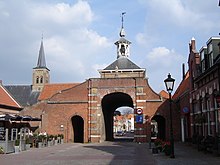Aardenburg
 flag |
 coat of arms |
| province |
|
| local community |
|
|
Area - land - water |
31.82 km 2 31.51 km 2 0.31 km 2 |
| Residents | 2,500 (Jan. 1, 2017) |
| Coordinates | 51 ° 16 ′ N , 3 ° 26 ′ E |
| Important traffic route |
|
| prefix | 0117 |
| Postcodes | 4501, 4524, 4527-4529 |
| Website | Homepage of Aardenburg |
| Location of Aardenburg in the municipality of Sluis | |
Aardenburg (formerly also Rodenburg ) is a place in the Dutch municipality of Sluis in the province of Zeeland . The place has 2,500 inhabitants (as of January 1, 2017) and is just before the border with Belgium . Aardenburg was an independent municipality until 1995, which was merged with the municipality of Sluis to form the new municipality of Sluis-Aardenburg , whose main town was Aardenburg. In 2003, Sluis-Aardenburg merged with the municipality of Oostburg to form the larger municipality of Sluis.
history
At the site of today's Aardenburg there was an approximately 10 hectare large vicus of unknown name in Roman times , which is likely to have flourished in the 2nd and 3rd centuries in particular. The foundations of some large stone buildings and a Celtic-Roman temple were excavated there. The local Roman fort "Castellum Radannum" was built around 175 by the Roman governor of the province of Gallia Belgica , Didius Julianus . Aardenburg's military function lasted until around 270.
In the early Middle Ages the city was called Rodenburg or Rodenborg . In the 12th, 13th and 14th centuries it was an important outer port for Bruges , important because of the cloth production and a member of the Hanseatic League . In 1280, the German Hanseatic merchants relocated their trading activities to Aardenburg for two years, as they were discriminated against on the Bruges trading center. In the course of the 14th century, Aardenburg's trade and cloth industry suffered a slump. Troops from Ghent destroyed it in 1383.
Emperor Charles V did not succeed in re-establishing Aardenburg as an important market town. After the conquest by Moritz von Nassau in 1604 , the city was reduced by two thirds. In 1672 it was besieged by the French in vain. Their prosperity has fallen since the inroads of the Meuse into the neighboring country and the resulting swamping of the area.
Attractions
In Aardenburg, the " Sint-Baafskerk " is a very well preserved relic of the Scheldt Gothic . It is also a UNESCO World Heritage Site .
Sons and daughters of the place
- Leoni Cuelenaere (* 1952), diplomat
- Ate de Jong (* 1953), film director, screenwriter and film producer
See also
Web links
- Place website (Dutch)
- Aardenburg: Website of the tourist office VVV Zeeland (German, Dutch, English)
- Richard Stillwell, ed. Princeton Encyclopaedia of Classical = Sites , 1976: Aardenburg
- J. Kuyper, Gemeente Atlas van Nederland , 1865-1870, "Aardenburg" map of the former municipality from 1868
Individual evidence
- ↑ a b Kerncijfers wijken en buurten 2017 Centraal Bureau voor de Statistiek , accessed on April 10, 2018 (Dutch)







